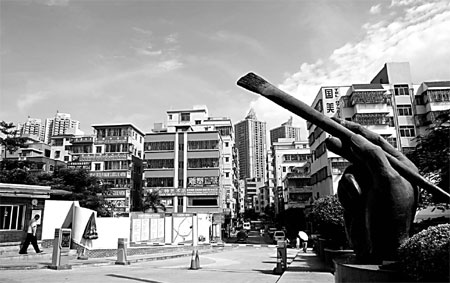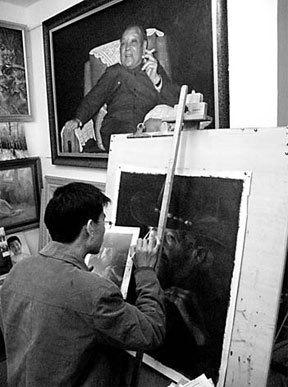 |
|
The entrance to Dafen Village. [File photo] |
Andy Warhol once said "making money is art". Forget that he died 22 years ago and you could be forgiven for thinking he dreamt up his philosophy in Dafen, an artistic colony in the eastern suburbs of Shenzhen.
The world's largest production base for oil paintings, Dafen is a labyrinth of streets and back alleys lined by art shops, brimming with the works of every famous name in art history.
Every genre is given equal wall space, from poetic French Impressionism to prosaic Russian realism, from classical Italian Renaissance to cartoonish pop art. The young Napoleon on a rearing horse (by Jacques-Louis David) is sandwiched between Rembrandt's alluring nudes and the equally amorous, gilded canvasses of Gustav Klimt.
Then there are Van Gogh's ubiquitous sunflowers, potent symbol of Dafen's commercial success, built over two decades of mass-producing and exporting art to the rest of the world. These days, though, the unsold paintings are more like reminders of a once-healthy appetite for art that has turned sluggish amid the unraveling global economic crisis.
"This is the first time in Dafen's history that its growth has been halted," says Huang Jiang, the "Godfather of Dafen" who earned the name by single-handedly inventing the so-called "Dafen Model".
Huang believes the current financial turmoil can have a long-term impact on a place that has only just begun to fulfill its lofty ambitions. "There has been so much talk of transforming Dafen from a mere manufacturer of cheap knock-offs to a real center for art," he says. "But how could you do this when the lifeline of the artists has been cut off?"
Huang says artists in Dafen have always managed to stay afloat by exporting their replicas to overseas buyers. "The income they earned from copying other painters ensured they could paint whatever they liked in their spare time," he says.
Now, with overseas orders down by 80 percent, Dafen artists are being forced to live from paint-encrusted hand to mouth.
Behind almost every door on the street are people - some may be reluctant to call them artists - bent over painting boards, with one hand holding a brush and the other, an art catalogue or a photograph from which they "faithfully" transcribe the image.
Asked if they would like to paint their own works, the answers are more or less the same.
"What if no one likes it?," they ask. "How could I pay for my food, clothing and rentals?"
 |
|
A replica painter at work. [Zhao Xu] |
Remarks like this worry Huang. "What I'm most unwilling to see is Dafen sliding back to its old days," he says, pausing for a long while. "They are exciting times though."
In 1989, Huang, an art student-turned-entrepreneur, arrived in Dafen with no more than 20 apprentice painters and workers. The reason he moved there, from another area of Shenzhen, was because of the cheap rent, which enabled them to charge a mere 100-200 yuan ($14.60-29.20) for a full-size Picasso. The orders began flying in. At its peak, Huang's company received one order from Walmart asking for 50,000 paintings to be delivered within three months.
"What am I going to do?" Huang had thought anxiously. "That's when I stumbled upon this idea." Under Huang's "Dafen Model", each painter was responsible for one part of the canvas - say, a cottage at the foreground, or a misty mountain in the background. The final touch-up was left to a senior painter, who made sure that the finished work bore only one person's fingerprint.
It's akin to a production line minus the droning of machines but Huang says the experience offered much-needed training for painters still struggling with their newly acquired skills.
"Most of our employees were young men and women from rural China who had a certain gift for painting but had received no formal training," he says. "And keeping in mind that in the early 90s, oil painting techniques were still not widely taught in art schools in China, even those who did go to a painting academy had to start from scratch."
The most efficient - and Huang believed the best - way to learn it would be to imitate the masters, brushstroke by brushstroke.
The days when 1,000 painters worked around the clock to fill one hefty order has long gone, in part because so many businesses have been set up in the past few years to capitalize on the fast-expanding consumer market for art, both home and abroad.
Dafen today has more than 800 art companies and studios, many founded by his former students and employees. Its annual turnover reached 350 million yuan in 2007 and its population multiplied from 300 to 16,000.
Its phenomenal commercial success, however, has also proved to be its undoing. The more replicas it sells, the more the village is associated with cheap pastiches and tackiness.
Dafen has tried to lift its image, with original, creative works by resident artists being auctioned at locally organized events. The village has also set up its own certification authority to ensure that buyers of original works get their money's worth.
In May 2007, the 100 million yuan Dafen Art Museum opened to the public to showcase Dafen's homespun artists and stand as a symbol of its artistic revival.
The current economic crisis, as devastating as it might become, could also be a touchstone for creative talents, according to a local painter who would only identify himself as Mr Li.
"All of a sudden, people realize that they should save money for something that has real value, an authentic painting instead of a thoughtless copy," he says. "While the big export companies stand to lose hundreds of thousands, we individual artists who persist in making our own art may actually gain from a newfound appreciation for our independent work."
That being said, Li is by no means trying to distance himself from other "lesser" painters. "I give myself the penname 'Log Bridge' - all of us are on the same bridge," he says.
When he arrived at Dafen in 2002, after graduating from a painting academy in Henan, Li started like everybody else, by painting replicas.
"There's no shame in it. Back then, the market for contemporary art was so small that without Dafen, those of us who had learned painting but couldn't find a job to paint would have quit completely," he says.
"One can easily dismiss a replica as 'a piece of rubbish' but a few years ago, having one at home was for many people their first contact with art."
The collective taste has improved a lot since then, and Dafen, after enjoying a boom for 20 years, is facing uncertain times. But amid the tumultuous changes, Li sees a distinctive path for himself that has remained unchanged.
"Everyone in Dafen has two choices: to settle down into the mode of a replica painter or to persist and wait for that crucial breakthrough," he says. "Those who have yet to make it have embers in their heart - warm and long-burning.
"That fire will not die."
(China Daily January 20, 2009)